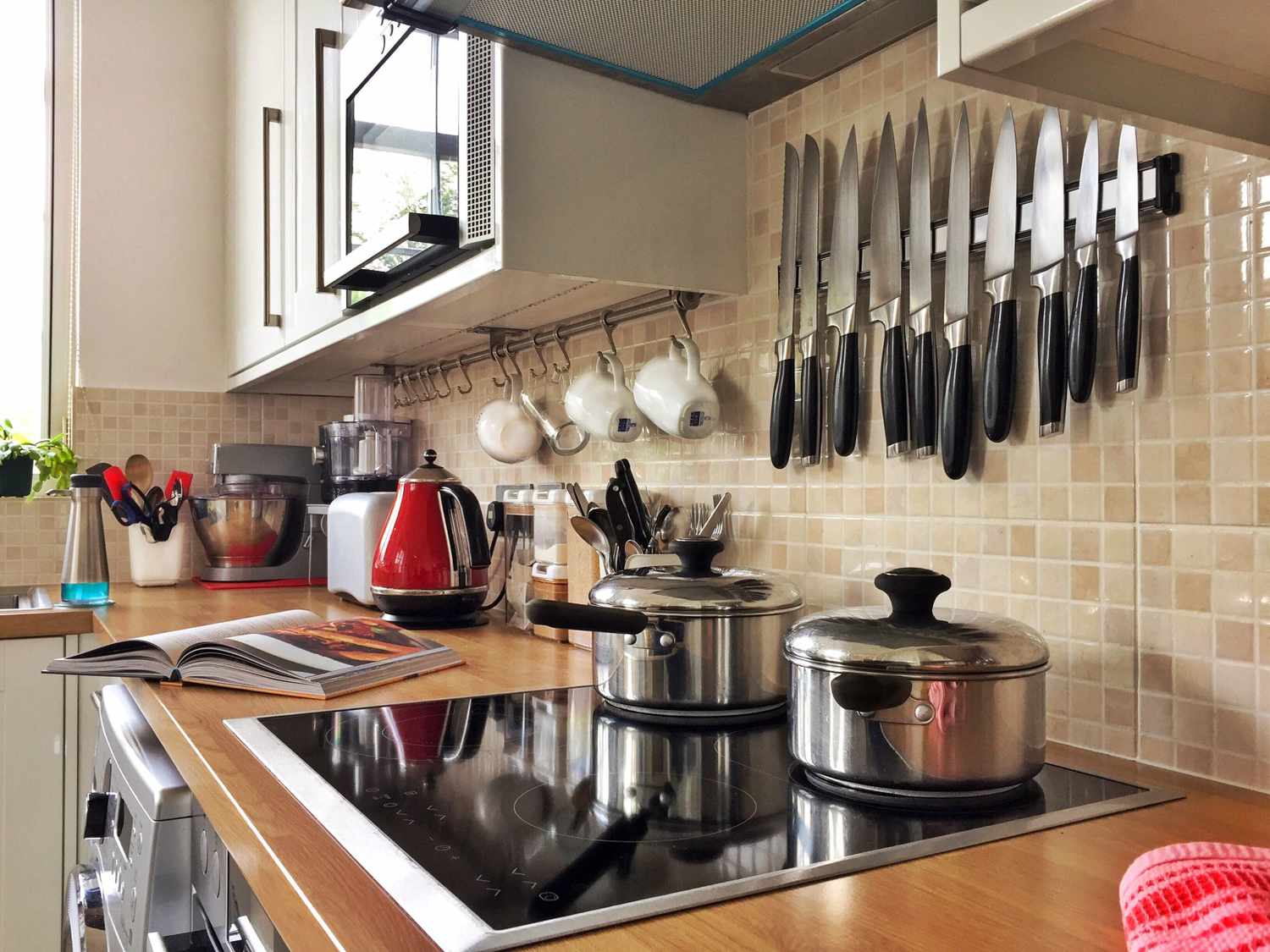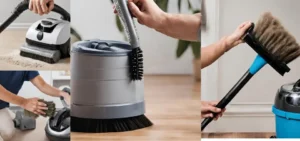To clean your kitchen, start by removing all items from countertops, wiping them down with a damp cloth, and cleaning any spills or stains. Then, wash dishes, utensils, and cookware in hot, soapy water, and dry them thoroughly.
Sweep or vacuum the floor, and mop it with a mixture of water and a floor cleaner. Finally, clean appliances by wiping them down with a suitable cleaner and scrubbing any stubborn stains. Don’t forget to clean the sink and drain, and dispose of any food waste properly.
How to Clean Kitchen Quickly
Decluttering Before Cleaning
When it comes to cleaning the kitchen, decluttering is an essential first step. By sorting items into keep, recycle, and dispose piles, and organizing drawers and cabinets efficiently, you can ensure a clean and organized space that is easier to maintain in the long run.
Sorting Items Into Keep, Recycle, And Dispose Piles
Before you start cleaning the kitchen, take the time to sort through your items. Begin by creating three piles: keep, recycle, and dispose. This simple step can help you eliminate clutter and free up valuable space in your kitchen.
To effectively sort your items, follow these steps:
- Empty out one drawer or cabinet at a time.
- Assess each item and determine whether it is worth keeping, recycling, or disposing of.
- Keep items that are regularly used and in good condition. Donate or sell items that you no longer use but are still in good shape.
- Recycle items such as plastic containers, paper, and glass bottles that can be easily recycled.
- Dispose of any items that are broken, expired, or no longer functional.
By dedicating some time to decluttering and sorting your items, you can create a more organized kitchen that is easier to clean. Plus, by recycling and disposing of unwanted items properly, you are contributing to a greener environment.
Organizing Drawers And Cabinets Efficiently
Once you have sorted your items, it’s time to organize your drawers and cabinets efficiently. An organized kitchen not only looks neat but also saves you time and frustration when you’re searching for a specific item.
Here are some tips to help you organize your kitchen drawers and cabinets:
- Group similar items together. For example, store all your baking utensils and tools in one drawer or cabinet, and keep your pots and pans together in another.
- Use dividers or organizers to keep items separated and easily accessible.
- Consider utilizing vertical space by adding shelves or hooks to maximize storage.
- Label containers and shelves to make it easier to find what you need.
By organizing your kitchen efficiently, you create a more functional space where everything has its place. This not only makes it easier to clean but also simplifies your daily cooking routine and eliminates unnecessary stress.
Attacking Stubborn Grease Spots
Learn how to easily tackle stubborn grease spots in your kitchen with these effective cleaning tips. Keep your kitchen sparkling clean and grease-free with these simple and practical solutions.
Introduction: Attacking Stubborn Grease Spots
Grease and oil are common culprits that can leave stubborn spots and stains in your kitchen. Whether it’s on your countertops, stove, or kitchen appliances, these grease spots can be quite challenging to remove.
Identifying Common Grease Accumulation Areas
Grease tends to accumulate in specific areas in the kitchen. By identifying these common problem areas, you can tackle grease spots more effectively. Here are a few areas to keep an eye on:
- Cooking Surfaces: Stovetops and grills are prone to heavy grease buildup, especially around the burners or grates.
- Range Hoods: The filters in range hoods trap grease, and if not cleaned regularly, can cause greasy residue to accumulate on the surface.
- Cabinets and Appliances: Nearby cabinets, handles, and knobs are often overlooked but can accumulate greasy residue from cooking and regular use.
- Frying Pans and Cookware: Pots and pans used for frying or sautéing are likely to have stubborn grease spots.
Natural And Commercial Solutions For Grease Removal
When it comes to removing grease spots, you have both natural and commercial solutions at your disposal. Here are some effective methods:
Natural Solutions:
If you prefer a more eco-friendly approach, these natural solutions can help eliminate stubborn grease spots:
- Vinegar: Mix equal parts white vinegar and water in a spray bottle. Spray the solution onto the grease spots, let it sit for a few minutes, and then wipe it away with a damp cloth. The acidic properties of vinegar help break down the greasy residue.
- Baking Soda: Create a paste by mixing baking soda with water. Apply the paste to the grease spots and scrub gently with a sponge or cloth. Rinse with water and wipe the area dry.
- Lemon Juice: Squeeze fresh lemon juice onto the affected areas and let it sit for a few minutes. The citric acid in lemon juice helps cut through grease. Scrub lightly with a sponge and rinse with water.
Commercial Solutions:
If you’re dealing with stubborn grease spots that natural solutions can’t handle, there are various commercial products available:
| Product | Description |
|---|---|
| Degreaser Spray: | A powerful cleaner specifically designed to remove grease and oil. Simply spray it on the affected area, let it sit for a few minutes, and wipe clean. |
| All-Purpose Cleaner: | Many all-purpose cleaners are effective at cutting through grease and can be used on multiple surfaces. Follow the instructions on the label for the best results. |
| Commercial Wipes: | Convenient and pre-soaked with cleaning agents, these wipes are excellent for quickly tackling grease spots. They can be used on various surfaces. |
With these natural and commercial options at your disposal, you can easily attack stubborn grease spots in your kitchen. Regular maintenance and cleaning will help prevent grease buildup and ensure a clean and inviting cooking space.
Freshening Kitchen Appliances
To truly have a fresh and clean kitchen, it’s essential to pay attention to your kitchen appliances. From the refrigerator that stores your food to the oven where you cook your meals, these appliances can accumulate dirt, grime, and odors over time. In this section, we will explore effective techniques for freshening your kitchen appliances, giving them a new lease of life.
refrigerator: Removing Shelves And Bins
When it comes to cleaning your refrigerator, it’s important to go beyond simply wiping down the interior. Start by removing all the shelves and bins from the fridge. This will allow you to access those hard-to-reach corners and ensure a thorough cleaning. Take note of where each shelf and bin belongs so it’s easy to reassemble everything later.
To clean the shelves and bins effectively, soak them in a mixture of warm water and mild dish soap. Gently scrub them with a sponge or soft brush to remove any stubborn stains or residue. Rinse thoroughly and allow the shelves and bins to dry completely before placing them back in the refrigerator.
oven: Baking Soda And Vinegar Method
Cleaning the oven can be a daunting task, but with the right technique, it doesn’t have to be a hassle. One effective method is using a combination of baking soda and vinegar. This natural cleaning solution is not only powerful but also safe to use.
Start by removing the racks and any other removable parts from the oven. Create a paste by mixing baking soda with a small amount of water. Apply this paste to the interior of the oven, focusing on areas with built-up grease and grime. Let it sit for a few hours or overnight to allow the baking soda to work its magic.
After the baking soda has had time to work, it’s time to break out the vinegar. Fill a spray bottle with vinegar and spritz it onto the baking soda paste. The mixture will start to fizz, which helps to loosen stubborn stains and residue. Use a sponge or scrub brush to gently scrub away the grime.
Once you’ve scrubbed the entire oven, wipe away the remaining baking soda and vinegar mixture with a damp cloth or sponge. Rinse thoroughly and dry the oven with a clean towel. Remember to clean and replace the racks and other removable parts before using your freshly cleaned oven again.
:max_bytes(150000):strip_icc()/blue-white-kitchen-6c293c9d-0221-269a5c7c1ba34c6fafa81ddfc851e230-horiz-0ac30870ea0d42568b5e457da5221d9d.jpg)
Credit: www.marthastewart.com
Detailing Small Appliances
When it comes to keeping your kitchen sparkly clean, don’t forget about your small appliances. They may be small in size, but they play a big role in your everyday cooking routines. Regular maintenance and deep cleaning of small appliances like coffee makers, microwaves, and toasters not only help them perform at their best but also extend their lifespan. In this section, we will delve into the nitty-gritty of cleaning and maintaining these essential kitchen tools. Let’s start with coffee makers.
Coffee Makers
Are you a coffee lover who enjoys a freshly brewed cup every morning? Keeping your coffee maker clean is essential to ensure that each cup of joe is as delicious as the first. Regular descaling and deep cleaning not only maintain the flavor but also prevent mineral deposits from clogging the machine.
- Make sure to unplug the coffee maker and remove any remaining coffee grounds.
- Remove the filter and wash it with warm, soapy water. Rinse thoroughly and let it air dry.
- Wipe down the exterior of the machine with a damp cloth.
- Fill the water reservoir with equal parts water and vinegar, setting the machine to brew a halfway cycle without the filter. Discard the solution.
- Rinse the reservoir and run a couple of cycles with clean water to remove any lingering vinegar taste.
For a deeper clean, you can even disassemble the coffee maker, following the manufacturer’s instructions, and clean individual parts thoroughly. Remember to consult the manual for specific instructions as different coffee makers have varying cleaning requirements.
Microwaves
If you rely on your trusty microwave for quick and convenient meals, keeping it clean is a must. Food splatters and spills can accumulate over time, leading to unpleasant odors and potentially affecting your food’s taste. Regular maintenance and a deep clean from time to time will keep your microwave running smoothly.
- After each use, wipe down the interior of the microwave with a damp cloth or sponge.
- Place a microwave-safe bowl filled with water and a few slices of lemon inside the microwave. Heat it for a few minutes until the water boils and the steam helps to loosen any stubborn stains. Carefully remove the bowl and wipe down the interior with a damp cloth.
- Wash the turntable and other removable parts with warm, soapy water, or simply place them in the dishwasher if they are dishwasher-safe.
- Don’t forget the exterior of the microwave! Use a mild cleaning solution and a soft cloth to wipe it down.
- Create a cleaning solution by mixing equal parts water and white vinegar in a microwave-safe bowl.
- Place the bowl inside the microwave and heat it on high for a few minutes until the mixture boils and steam fills the microwave. Let it sit for a few minutes.
- Remove the bowl, and carefully wipe down the interior, paying extra attention to any stubborn stains or spills.
- Finally, wipe down the exterior with a damp cloth.
Toasters
There’s nothing quite like the smell and taste of freshly toasted bread in the morning. However, crumbs and leftover debris can accumulate in your toaster, affecting its performance and even becoming a potential fire hazard. Regular maintenance and deep cleaning will help ensure that your toaster is toasting perfectly every time.
To keep your toaster clean regularly:
- Unplug the toaster and remove the crumb tray. Dump out any crumbs and wash the tray with warm, soapy water. Let it dry before reinserting it.
- Turn the toaster upside down and gently shake it to remove any additional crumbs.
- Wipe down the exterior of the toaster with a damp cloth.
If your toaster needs a more thorough cleaning:
- Again, unplug the toaster and remove the crumb tray.
- Using a soft-bristle brush or an unused toothbrush, gently scrub the toaster’s interior, removing crumbs and residue.
- Take a clean cloth dampened with warm water and wipe down the interior, making sure to remove any remaining debris.
- Once everything is dry, reinsert the crumb tray and plug the toaster back in.
Countertops And Backsplashes
Your kitchen countertops and backsplashes are essential elements of your kitchen’s design, providing both functionality and aesthetic appeal. However, they can quickly accumulate dirt, spills, and stains, making regular cleaning necessary to maintain their beauty and hygiene. In this section, we will discuss safe cleaning techniques for different materials used in countertops and backsplashes, along with protective measures to prevent future stains.
Safe Cleaning Techniques For Different Materials
Each type of countertop and backsplash material requires specific cleaning techniques to preserve their quality and lifespan. Here are some recommended methods:
Granite
Granite countertops are highly durable but require gentle cleaning to avoid damaging the surface. Follow these steps:
- Wipe the surface with a soft cloth or sponge dipped in warm water and mild dish soap.
- Rinse thoroughly with clean water to remove any soap residue.
- Dry the surface using a clean, lint-free cloth.
- For stubborn stains, create a paste of baking soda and water. Apply the paste to the stain, cover it with plastic wrap, and let it sit for a few hours before wiping it away with a cloth.
Marble
Marble countertops require extra care to preserve their natural beauty. Follow these steps:
- Gently wipe the surface with a soft, damp cloth and mild dish soap.
- Avoid using acidic or abrasive cleaners, as they can damage the marble.
- Rinse thoroughly with clean water and dry with a soft cloth.
- For tough stains, create a paste of baking soda and water. Apply the paste to the stain, cover it with plastic wrap, and let it sit overnight. Rinse with water and dry.
Protective Measures To Prevent Future Stains
In addition to regular cleaning, taking preventive measures can help keep your countertops and backsplashes looking their best. Here are some protective measures:
- Use cutting boards or trivets to avoid scratching or damaging the surface.
- Place coasters or mats under hot pots and pans to prevent heat damage.
- Wipe up spills immediately to prevent staining.
- Avoid using harsh cleaning chemicals that can strip the protective sealant.
By following these safe cleaning techniques and protective measures, you can keep your kitchen countertops and backsplashes in top condition, ensuring they remain both functional and visually appealing for years to come.
Sanitizing Sinks And Faucets
Welcome to the section on sanitizing sinks and faucets! Keeping your kitchen sink and faucets clean is crucial for maintaining a hygienic environment in your kitchen. In this blog post, we will discuss the best products that kill germs without damaging surfaces, as well as DIY cleaning mixes for sink freshness. Let’s dive in!
Products That Kill Germs Without Damaging Surfaces
When it comes to sanitizing your sink and faucets, using the right products is essential. You want to ensure that the products you use effectively kill germs while being gentle on your sink’s surface. Here are some recommended products:
| Product | Features |
|---|---|
| Bleach | Effective in killing germs and removing stains |
| Vinegar | Natural disinfectant that eliminates bacteria and odors |
| Hydrogen Peroxide | Powerful germ killer that is safe for most sink materials |
Before using any cleaning product, always read the instructions and test it on a small, inconspicuous area of your sink to ensure it doesn’t cause any damage. Now, let’s explore some DIY cleaning mixes for sink freshness:
Diy Cleaning Mixes For Sink Freshness
Creating your own cleaning mixes is not only cost-effective but also allows you to control the ingredients used. Here are a few simple DIY mixes that will leave your sink fresh and sanitized:
- Baking Soda and Lemon Juice: Mix baking soda and lemon juice to form a paste. Apply the paste to your sink and faucets and scrub gently using a sponge or cloth. Rinse thoroughly with water.
- Vinegar and Water: Combine equal parts vinegar and water in a spray bottle. Spray the mixture onto your sink and faucets, and let it sit for a few minutes. Scrub with a brush or sponge, then rinse with water.
- Hydrogen Peroxide and Dish Soap: Mix hydrogen peroxide and dish soap in a spray bottle. Spray the solution onto your sink and faucets, allowing it to sit for a few minutes. Scrub gently with a sponge or cloth, then rinse thoroughly.
Remember to always rinse your sink and faucets with water after using any cleaning solution to remove any residue or odors. Regularly sanitizing your kitchen sink and faucets will help prevent the spread of germs and keep your kitchen clean and fresh.
Sweeping, Mopping, And Protecting Floors
When it comes to keeping your kitchen clean and hygienic, sweeping, mopping, and protecting your floors play a crucial role. Not only do these tasks remove dirt, grime, and food particles, but they also help maintain the longevity and appearance of your kitchen floors. In this section, we will discuss the importance of choosing the right cleaning products and implementing preventative measures for floor protection.
Choosing The Right Cleaning Products
The key to effectively cleaning your kitchen floors is to use the right cleaning products. The choice of product depends on the type of flooring material you have. Let’s take a look at the different floor types and the corresponding cleaning products:
| Floor Type | Recommended Cleaning Products |
|---|---|
| Tiled or Vinyl Floors | Mild detergent solution or a specifically formulated tile or vinyl floor cleaner |
| Hardwood Floors | Hardwood floor cleaner or a mixture of vinegar and water |
| Laminate Floors | Laminate floor cleaner or a mixture of vinegar and water |
| Stone or Marble Floors | PH-neutral stone floor cleaner |
Remember to always follow the manufacturer’s instructions and test any new cleaning product on a small, inconspicuous area before applying it to the entire floor surface.
Preventative Measures For Floor Longevity
To ensure the longevity of your kitchen floors, it’s essential to implement preventative measures. Here are some tips to protect your floors from unnecessary damage:
- Place mats or rugs near high-traffic areas, such as the sink or stove, to catch dirt and liquid spills.
- Regularly sweep or vacuum your kitchen floors to remove any loose dirt or debris.
- Wipe up spills immediately to prevent stains or damage to the floor surface.
- Use furniture pads or felt protectors under the legs of chairs, tables, and other heavy objects to prevent scratches or dents.
- Avoid dragging heavy furniture or appliances across the floor. Instead, use furniture sliders or ask for assistance when moving them.
- Trim your pet’s nails regularly to prevent scratches on hardwood or laminate floors.
- Follow proper maintenance guidelines provided by the flooring manufacturer.
By following these preventative measures, you can keep your kitchen floors looking their best and extend their lifespan.
Deodorizing Trash Cans And Recycling Bins
Keeping your kitchen fresh and clean is essential, and one area that often requires special attention is your trash cans and recycling bins. These receptacles can quickly become a breeding ground for unpleasant odors if not properly cleaned. By incorporating regular cleaning routines into your kitchen maintenance, you can minimize these odors and maintain a clean and hygienic environment.
Start by emptying and cleaning your trash cans and recycling bins at least once a week. Remove any garbage or recycling materials and dispose of them properly. Then, using a mild dish soap or a mixture of water and vinegar, thoroughly clean the inside and outside of the containers. Rinse them well and allow them to air dry before using them again. This simple routine can help eliminate any lingering odors and keep your kitchen smelling fresh.
While regular cleaning can go a long way in preventing odors, sometimes you may need an extra boost to keep your trash cans and recycling bins smelling fresh. Natural deodorizers are a great way to achieve this without relying on harsh chemicals.
One effective deodorizer is baking soda. Simply sprinkle a generous amount of baking soda into the bottom of your containers before placing a new trash bag or adding any recyclables. Baking soda helps absorb and neutralize odors, keeping your bins smelling clean and fresh. Remember to replace the baking soda regularly to maintain its effectiveness.
Citrus peels are another natural deodorizer that can add a refreshing scent to your trash cans and recycling bins. Place orange, lemon, or lime peels at the bottom before adding any new trash or recyclables. The citrus oils in the peels help mask unpleasant odors and leave behind a pleasant fragrance. Plus, it’s a great way to repurpose citrus peels instead of throwing them away.
If you prefer a more subtle and continuous deodorizing option, try using activated charcoal. You can find small bags of activated charcoal designed for odor elimination in various stores. Place one of these bags in your trash cans and recycling bins to absorb and neutralize odors over time. Remember to replace the bags regularly for maximum effectiveness.
- Empty and clean your trash cans and recycling bins at least once a week using mild dish soap or a mixture of water and vinegar.
- Sprinkle baking soda into the bottom of your containers to absorb and neutralize odors.
- Add citrus peels to give your bins a refreshing scent while masking unpleasant odors.
- Consider using activated charcoal to continuously absorb and neutralize odors over time.
By incorporating these deodorizing techniques into your kitchen cleaning routine, you can ensure that your trash cans and recycling bins stay fresh and odor-free, contributing to a clean and pleasant kitchen environment.
Frequently Asked Questions On How To Clean Kitchen
How Often Should I Clean My Kitchen?
It is recommended to clean your kitchen daily to maintain hygiene and prevent the build-up of dirt and grease. Regular cleaning also helps in minimizing the growth of bacteria and other harmful pathogens.
What Are The Essential Kitchen Cleaning Supplies I Need?
To effectively clean your kitchen, you’ll need a few basic supplies such as dish soap, all-purpose cleaner, microfiber cloths, scrub brushes, and sponges. Additionally, baking soda, vinegar, and lemon juice can be useful for natural cleaning solutions.
How Do I Clean Kitchen Appliances?
To clean kitchen appliances, start by unplugging them and removing any removable parts. Wipe the surfaces with a damp cloth or use a suitable cleaner. For tough stains, a mixture of baking soda and water can be effective. Remember to read the appliance’s manual for specific cleaning instructions.
What Is The Best Way To Clean Kitchen Countertops?
For most kitchen countertops, a mild detergent or all-purpose cleaner and a soft cloth or sponge will do the job. Avoid using abrasive cleaners or scouring pads as they can damage the surface. Wipe up spills immediately to prevent stains, and regularly disinfect the countertops to maintain cleanliness.
Conclusion
Keeping your kitchen clean is essential for maintaining a healthy and organized space. By following the steps outlined in this blog post, you can easily and effectively clean your kitchen without becoming overwhelmed. Remember to regularly clean surfaces, appliances, and utensils, as well as declutter and properly dispose of waste.
By making cleaning a regular part of your routine, you can enjoy a clean and inviting kitchen for years to come.





